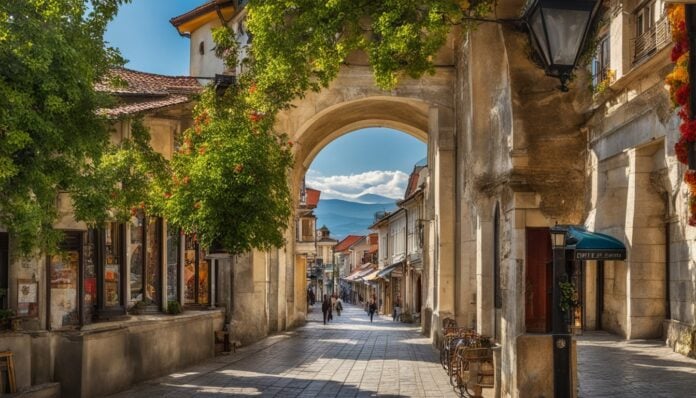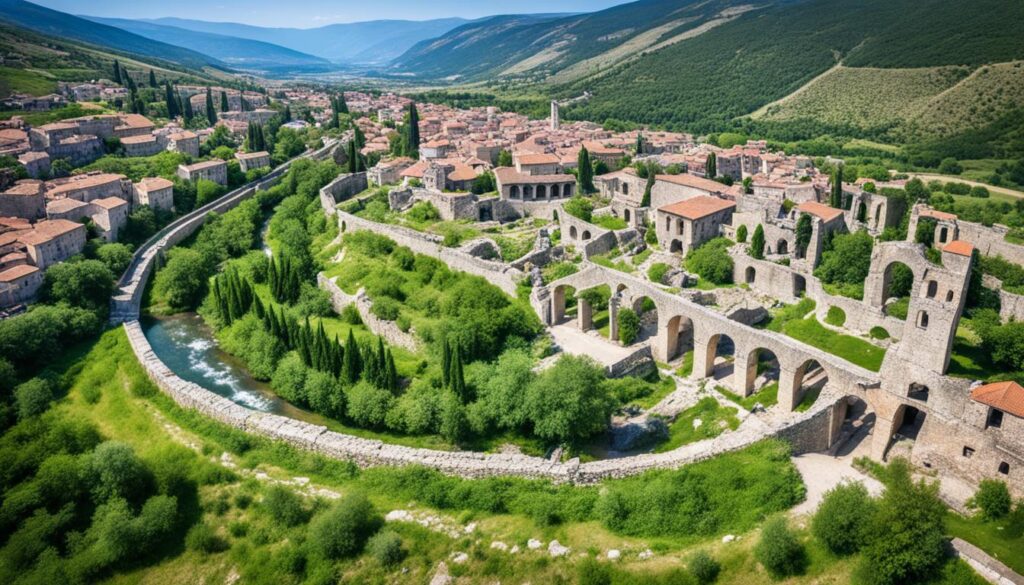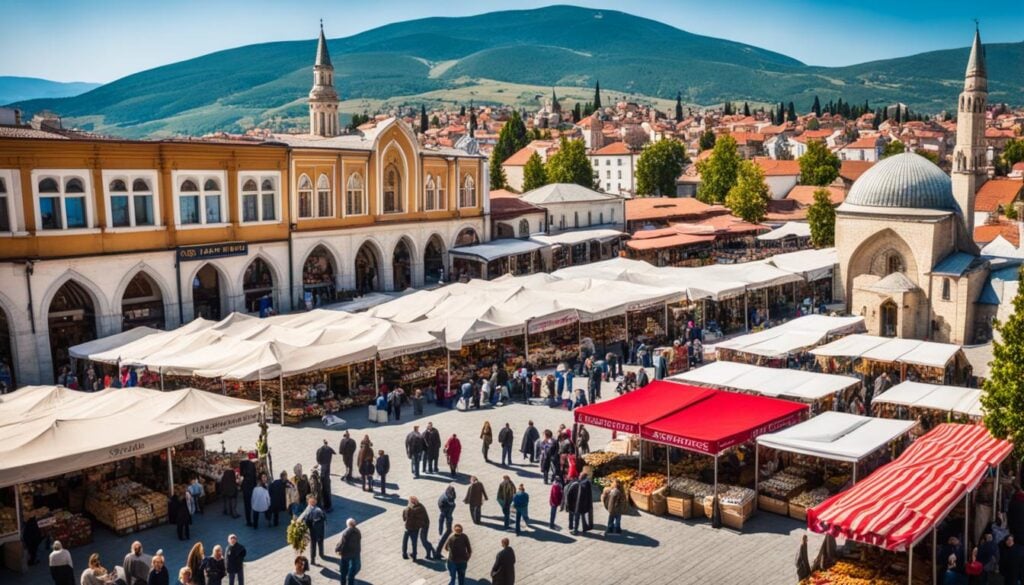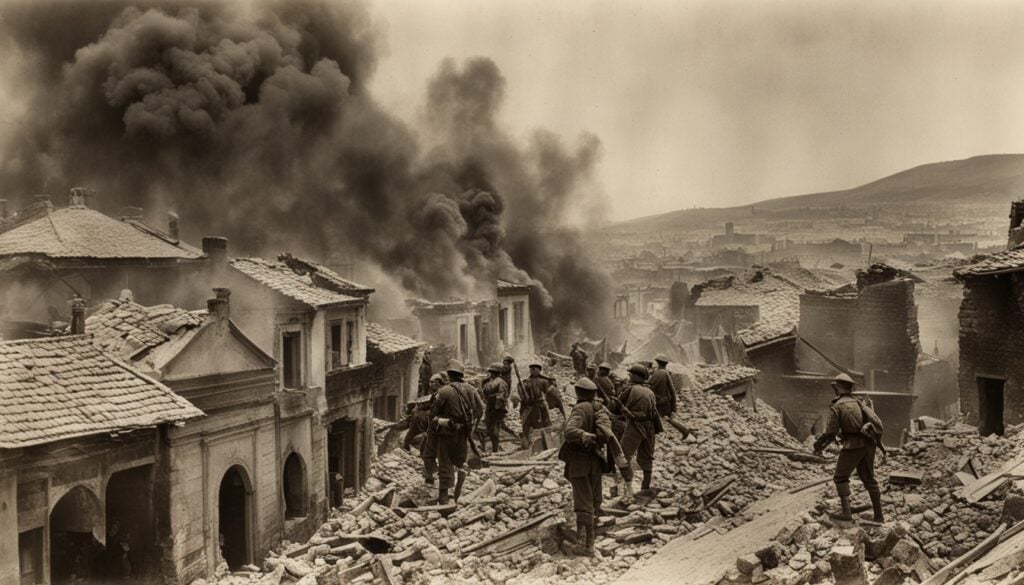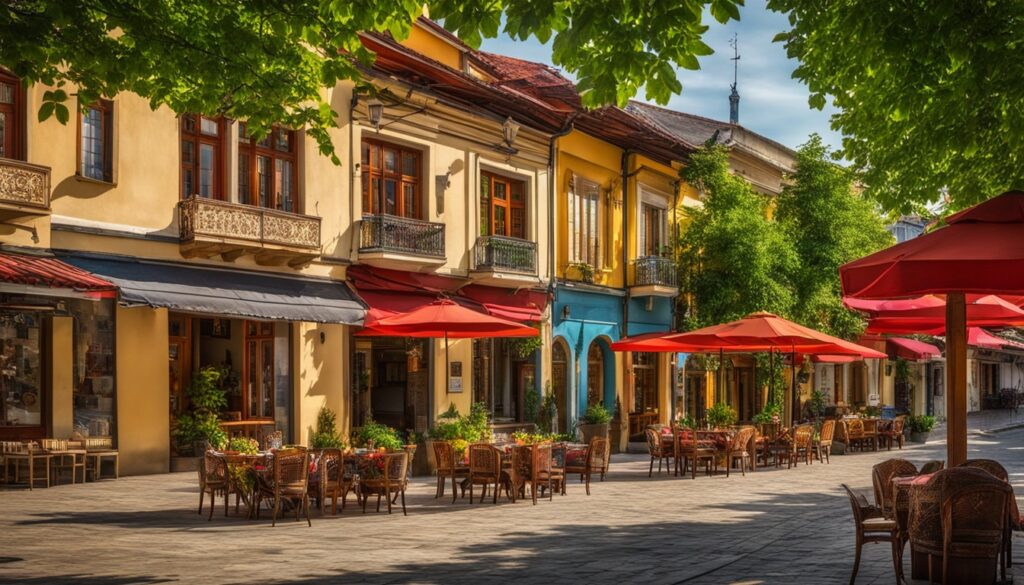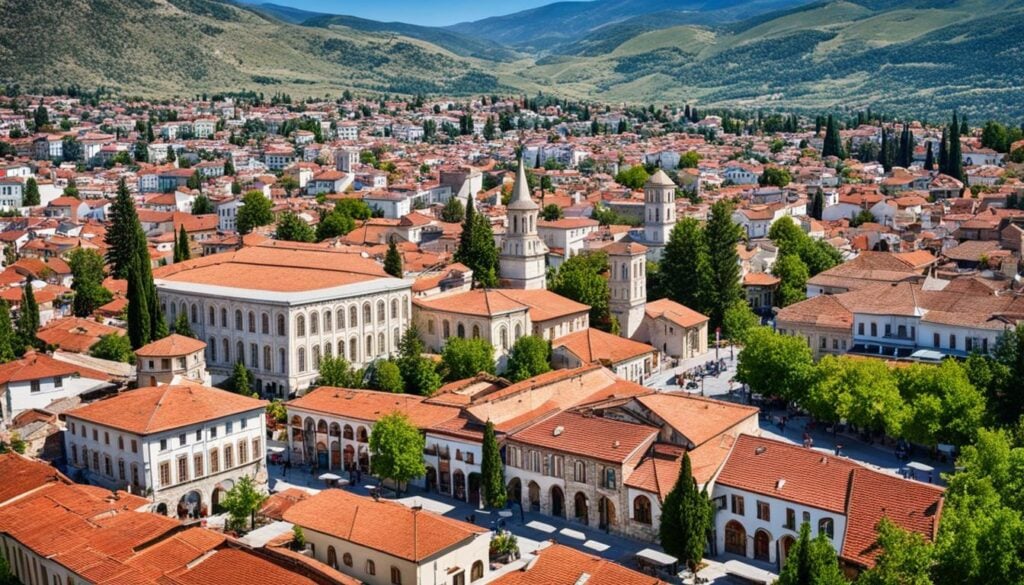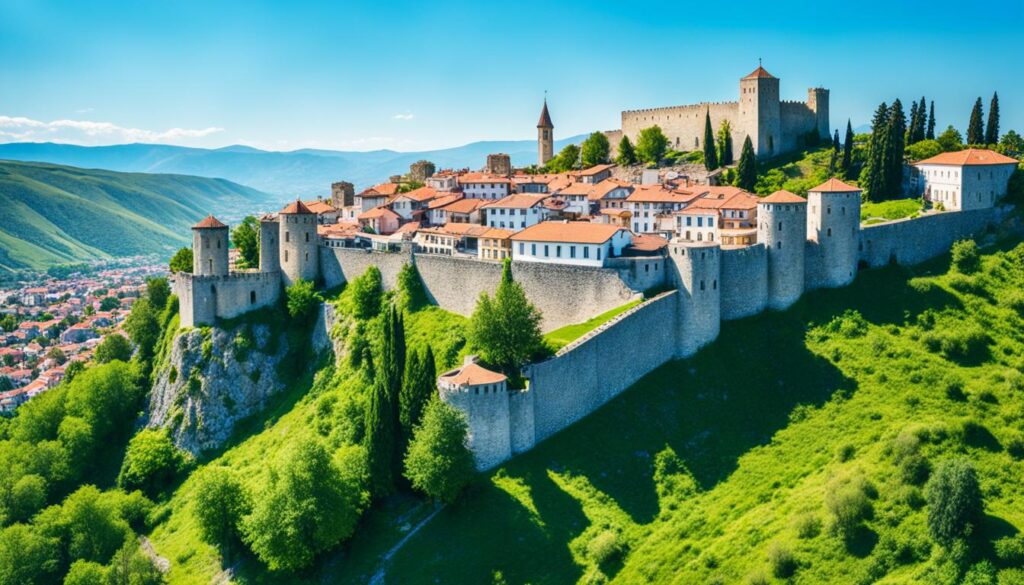Welcome to Bitola, a city with rich history and diverse culture. Ever wondered about the secrets of this ancient place? How did it start, and what events made it what it is today? Let’s dive into Bitola’s past and discover the amazing tales it hides.
Bitola has seen the span of history and played key parts in events. It has roots that go back many years. We’ll explore how Bitola was founded and how it has changed over time.
Jump into Bitola’s stories from when it was under the Ottoman Empire. This era left lasting impressions on Bitola’s buildings, traditions, and lifestyle. We’ll also look at how Bitola faced the Balkan Wars with courage.
Witness Bitola’s challenges during the World Wars and their aftermath. Feel the global wars on a local level. Discover the strength of Bitola’s people through their history.
Bitola’s cultural scene is thriving, rich in history, art, and literature. Explore the cultural wonders that continue to attract people worldwide. Bitola is a place of creativity and deep thought.
Let’s visit Bitola’s ancient sites that survived through the ages. You’ll see the beauty of the past in ruins, mosques, churches, and grand buildings. These are the echoes of Bitola’s history.
Now, Bitola is a modern city focused on growth. It keeps its old charm while welcoming progress. See how Bitola blends its history with a new era.
Lastly, we’ll explore today’s Bitola, full of life and culture. Feel the energy of this amazing city. Its blend of history and modern life offers a special experience to all visitors.
Join us on a journey to the heart of Bitola’s history. Discover its secrets, admire its architecture, and be moved by its people’s resilience. Bitola is waiting to amaze you.
Tracing the Origins of Bitola
Exploring Bitola reveals its deep history, making it a treasure in North Macedonia. This city has a diverse past, stretching back to ancient times. Evidence shows people lived here in the Neolithic era. Since then, Bitola has seen empires rise and fall, welcomed various cultures, and witnessed many historical events.
The story of Bitola starts in the 4th century BC as Heraclea Lyncestis, in the Kingdom of Macedon. When Rome took over, it thrived as a key stop on the Via Egnatia trade route. In the Byzantine times, it advanced culturally and religiously, building beautiful churches and monasteries.
Bitola changed hands between empires like the Bulgarians and the Byzantines. But it was the Ottoman rule that transformed the city. Bitola became the heart of the Bitola Vilayet, growing in economy and culture. Thanks to its strategic location, it became a key city in the Balkans.
The city thrived with a mix of Muslims, Christians, and Jews coexisting. It’s known for its lively bazaars, stunning mosques, and historic buildings. The Ottoman influence is clearly visible in Bitola’s architecture and culture, even today.
In the late 1800s and early 1900s, Bitola faced the Balkan Wars. These wars were fought over its strategic importance. After the conflicts, Bitola joined the Kingdom of Yugoslavia, marking a new chapter in its story.
The Timeline of Bitola:
- Neolithic period: Evidence of human habitation in the area.
- 4th century BC: Bitola is founded as Heraclea Lyncestis.
- Roman era: Bitola thrives as an important trade hub.
- Byzantine era: Cultural and religious development.
- Ottoman era: Bitola becomes a thriving center of commerce and culture.
- 19th-20th centuries: Bitola plays a significant role in the Balkan Wars.
- Post-war period: Bitola becomes part of the Kingdom of Yugoslavia.
Notable Quote:
“Bitola’s history is a testament to the resilience and adaptability of its people. The city’s origins can be traced back to ancient times, and its timeline is a testament to the diverse influences that have shaped its identity over the centuries.” – Dr. Elena Petrova, Historian
Population Breakdown:
| Ethnicity | Percentage |
|---|---|
| Macedonian | 60% |
| Albanian | 30% |
| Roma | 5% |
| Other | 5% |
Bitola in the Ottoman Empire
During the Ottoman Empire, Bitola was a key historical spot. It saw important events that defined the area’s culture. Bitola, called Monastir then, was a hub for trade, art, and learning in what is now North Macedonia.
It was a vital city, connecting different places and trade routes. This brought merchants and travelers from many places. Bitola’s economy grew, making it a diverse and lively place.
Bitola was strategically placed and became an important Ottoman administrative city. It was home to places like the Monastir Military High School. This showed how critical Bitola was for the empire’s military.
Bitola’s architecture shows the Ottoman impact and a mix of cultural styles. The buildings today reflect a unique blend of Ottoman, Islamic, and European designs.
“Bitola, with its charming blend of cultures and historical significance, serves as a testament to the Ottoman Empire’s legacy.”
But Bitola faced hard times when the empire weakened. The Russo-Turkish War and Treaty of Berlin changed things in the late 19th century. Bitola then came under Ottoman control again.
Bitola’s Ottoman Legacy
Bitola still carries its Ottoman heritage through its lively markets, old hammams, and the big fortress. These places remind us of Bitola’s rich history. People visit to feel its past.
Exploring Bitola, we find stories of the Balkan Wars and World Wars’ effects. Yet, its cultural legacy endures, making it a truly special place.
| Year | Historical Event |
|---|---|
| late 19th century | Russo-Turkish War and Treaty of Berlin |
| … | … |
| … | … |
Bitola’s Role in the Balkan Wars
Bitola, a city with a rich history, played a vital role in the Balkan Wars at the start of the 20th century. These wars, from 1912 to 1913, aimed to change the political and territorial face of the Balkans. Bitola was a key city, making it a major battleground.
Bitola was once the capital of the Ottoman Empire’s Manastir Vilayet. Its historical role meant many sought to control it. The city’s location between the Balkans and the Middle East added to its importance.
In 1912, the First Balkan War began. The Bulgarian army, with help from Greece and Serbia, fought the Ottomans to control key areas. Bitola was highly coveted due to its significance and location.
After the Ottomans retreated, there was fierce fighting in Bitola. The Battle of Bitola saw Bulgarian and Serbian forces battling intensely. The city changed ownership several times, underlining its strategic value.
The Siege of Bitola
The siege of Bitola by the Greeks was a significant event. They surrounded the city, cutting off supplies to the Ottomans. This siege, with artillery attacks, lasted for months.
In November 1912, the Ottomans in Bitola surrendered to the Greeks. This event was a crucial moment in the Balkan Wars. It greatly influenced the peace talks that followed.
Bitola’s role in the Balkan Wars transformed the city and the Balkan region. After the wars, Bitola became a part of the Kingdom of Serbia.
These wars and their aftermath shaped Bitola’s future. Today, Bitola reflects on its past with historical sites. It honors its wartime resilience and importance.
Bitola in the World Wars
Bitola is a city that played a big role during the World Wars. Its location was crucial, making it a target for many groups. By learning about Bitola’s history and seeing its sites, you can understand how deeply it was involved in the 20th century wars.
During World War I, Bitola saw fierce fighting as the battle lines moved. It was under Ottoman rule but was taken over by many, including the Central Powers and the Entente. This changed Bitola forever.
In World War II, Bitola faced chaos again. Bulgarian forces occupied it until 1944 when the resistance won back the city. The war caused a lot of damage, but Bitola’s people were strong.
Even with the difficulties of the World Wars, Bitola’s historic places stayed standing. The Church of St. Demetrius, an old Orthodox church, survived bombs in WW2. Its beauty shows Bitola’s rich culture.
| Bitola in World Wars | Description |
|---|---|
| Occupation | Bitola witnessed multiple occupations during both World War I and World War II. |
| Battles | The city became a battleground during World War I as the frontlines shifted across the Balkans. |
| Resistance | Bitola experienced resistance movements during World War II that ultimately led to its liberation. |
| Historical Sites | Despite the destruction, important historical sites like the Church of St. Demetrius endured. |
The World Wars deeply affected Bitola and its people. Their history is marked by these events, as shown in the city’s historic sites. Exploring Bitola’s past helps you see its strength and rich heritage in a new light.
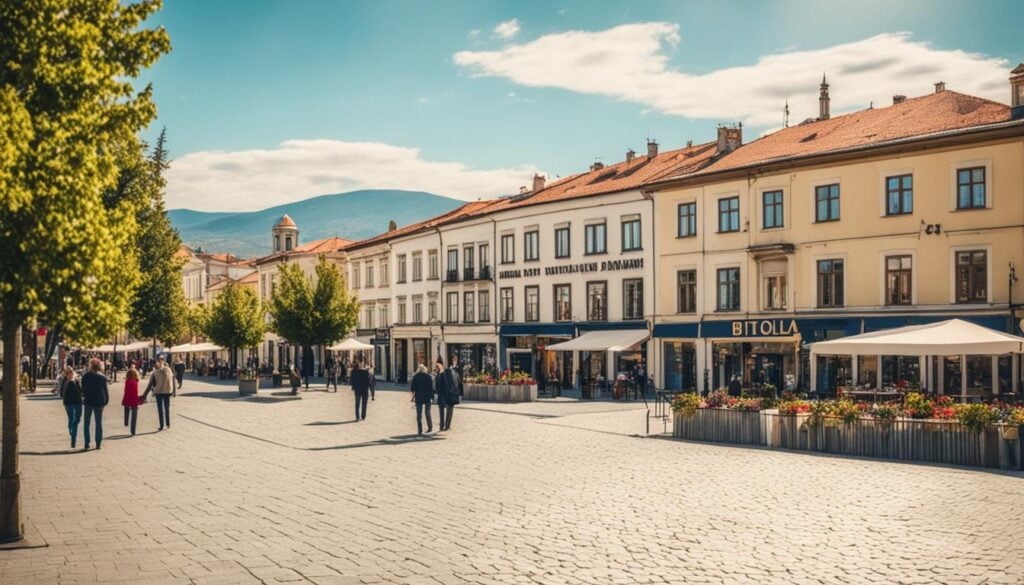
Cultural Heritage of Bitola
Bitola is known for its rich history and lively cultural scene. It showcases diverse architecture, cultural traditions, and art. These elements reflect Bitola’s past glory.
The city’s buildings tell a story. You’ll find mosques and bazaars from the Ottoman era mixed with neoclassical 19th-century structures. Walking down Sirok Sokak or visiting Magnolia Square shows Bitola’s varied influences beautifully.
Bitola cherishes its cultural past. Generations have passed traditions like music and dance. It hosts events like the Manaki Brothers International Film Festival, celebrating its cinema history.
Bitola is also a hub for art and literature. Many famous artists and writers have found inspiration here. The Bitola National Theater and Bitola Museum promote art and culture.
Visiting Bitola’s museums is a great learning experience. The Bitola Museum and Mustafa Kemal Atatürk’s Memorial House are cultural treasures. They offer insight into the area’s rich history.
“Bitola’s cultural heritage is a tapestry of influences and stories, weaving together the threads of its past, present, and future.”
Bitola’s cultural heritage breathes life into its identity. It’s more than just old things and pretty buildings. It’s a story of diversity and richness that continues to inspire. It shows why preserving and enjoying cultural heritage matters to all.
Historical Sites in Bitola
Travel through Bitola’s history by visiting its ancient sites. You’ll see ruins and preserved places that tell stories. These places show Bitola’s important role in the past of Macedonia.
1. Heraclea Lyncestis
Start at Heraclea Lyncestis, a city from the 4th century BCE. Its Roman ruins are in great condition. You can see a theater, basilicas, and beautiful mosaic floors. Walk among these old buildings and be amazed by their ancient beauty.
2. Bitola Clock Tower
The Bitola Clock Tower marks Bitola’s link with the Ottoman Empire. It was built in the 17th century. From its top, you can see the town below. It’s a unique chance to blend history with a great view.
3. Ishak Bey Mosque
Next, visit the Ishak Bey Mosque from the 15th century. Its design is stunning, with detailed paintings and calligraphy. As you visit, you can appreciate Bitola’s Ottoman history and find a peaceful spot for thoughts.
4. Yeni Mosque
The Yeni Mosque is another Ottoman gem. Inside, you’ll see impressive domes and delicate details. It’s a spot to feel calm and reflect.
5. Jeni Hammam
The Jeni Hammam is an old Turkish bathhouse from the 16th century. It mixes Ottoman and Byzantine styling. You can explore and see how people bathed in the past.
6. Shirok Sokak
Shirok Sokak is Bitola’s lively street with a long history. Walk past neoclassical buildings, cafes, and shops. It’s a great way to feel the city’s energy and beauty.
Diving into Bitola’s history and culture is fascinating. Each site holds a piece of the city’s past. They teach us about its rich heritage.
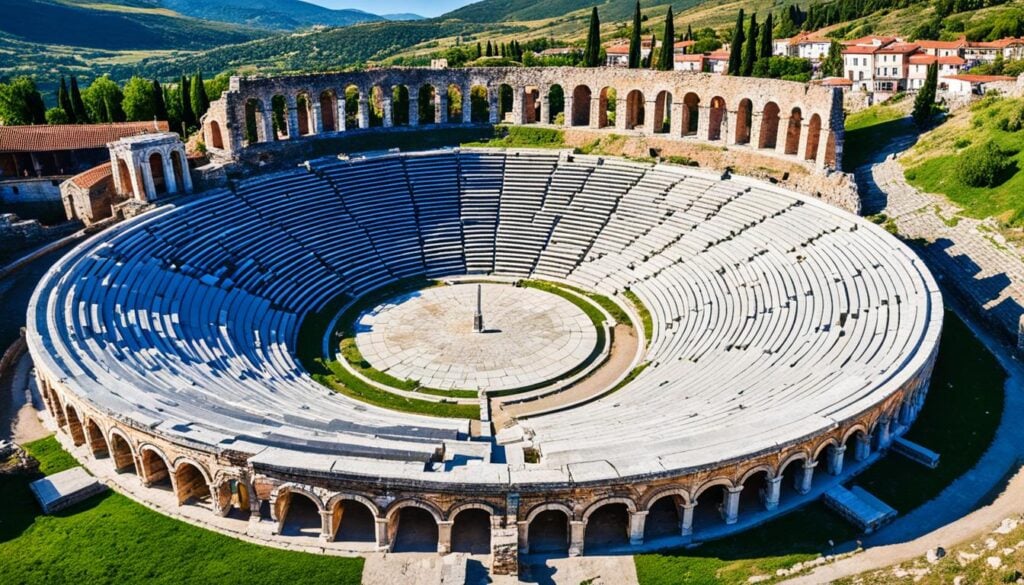
| Historical Sites | Description |
|---|---|
| Heraclea Lyncestis | An ancient city with well-preserved Roman ruins. |
| Bitola Clock Tower | An iconic Ottoman landmark offering panoramic views. |
| Ishak Bey Mosque | An architectural masterpiece showcasing rich Ottoman heritage. |
| Yeni Mosque | A stunning mosque adorned with intricate details. |
| Jeni Hammam | A traditional Turkish bathhouse with a historical charm. |
| Shirok Sokak | A lively pedestrian street with neoclassical buildings. |
Bitola’s Modern Transformation
Bitola has changed a lot over the years. It’s blended its rich history with new trends and advancements. This mix has made it a unique and fascinating place to visit.
One key change is how Bitola keeps its past important. The city knows its history is special. So, by sharing past events, it lets people step into its history.
Modernizing Bitola hasn’t hurt its rich culture. The city takes pride in its old sites. The famous Heraclea Lyncestis and the Clock Tower show off its colorful past.
Bitola’s now known for its lively arts and culture. It welcomes creative people from worldwide. The Bitola Film Festival is proof of its growing film scene and support for new talent.
Bitola is also modern in how it looks and works. Old and new blend well here. You can walk by old buildings, shop at new places, and enjoy the latest in tech.
This modern Bitola has become a top spot for visitors. It mixes old stories, new culture, and fun. Walking its pretty streets or diving into its arts is a promise of a great time. It really ties the past and the now together.
Contemporary Bitola: Cultural Hub and Tourist Destination
Bitola is a city at the heart of the Balkans. It mixes its rich history with today’s need for tourism. This blend has turned Bitola into a top culture spot and a must-see place for travelers.
The Cultural Melting Pot
Bitola’s culture comes from many influences. Over time, the city has absorbed customs from the Ottoman, Byzantine, and European cultures. This has created a unique mix visible everywhere, from the streets to the buildings.
Exploring Bitola means diving into its vibrant arts scene. You can visit theaters, galleries, and the famous Bitola Theater. The Manaki Brothers Film Festival also calls Bitola home, bringing films and filmmakers from all over.
Historical Treasures
Bitola’s past is alive in its many historic sites. The Bitola Old Bazaar is a must-see, where people can find traditional goods. The place is like a time machine thanks to its old architecture.
The Magnificent Clock Tower stands out as a sign of Ottoman times. It offers a great view of Bitola’s streets and mountains from the top. There’s also the Heraclea Lyncestis site, where ancient ruins and mosaics show Roman life.
Cultural Events in Bitola
| Event | Date | Description |
|---|---|---|
| Bitola Cultural Summer | July-August | A series of concerts, theater performances, and art exhibitions held throughout the city during the summer months. |
| Manaki Brothers Film Festival | September | An international film festival dedicated to cinematography, showcasing a diverse selection of films from around the world. |
| Dolno Konjari Art Colony | August | An annual art colony where artists gather to create and exhibit their works in various mediums. |
Bitola is great for both history buffs and art fans. Its mix of traditions and its lively arts scene make it stand out. Visiting Bitola is an unforgettable journey into the past and the modern face of this historic city.
Conclusion
Bitola’s history is a captivating journey through time. It started in ancient times and continues today. The city’s charm and historical value remain strong. Its history with the Ottoman Empire, the Balkan Wars, and World Wars is fascinating.
Bitola values its cultural heritage, seen in many sites and landmarks. These places highlight the city’s past and its lasting impact.
Today, Bitola is a top place for tourists. People come from everywhere to see its culture and buildings. With its beautiful scenery and rich history, Bitola offers a chance to explore its past. It’s an invitation to discover its interesting tale.

































